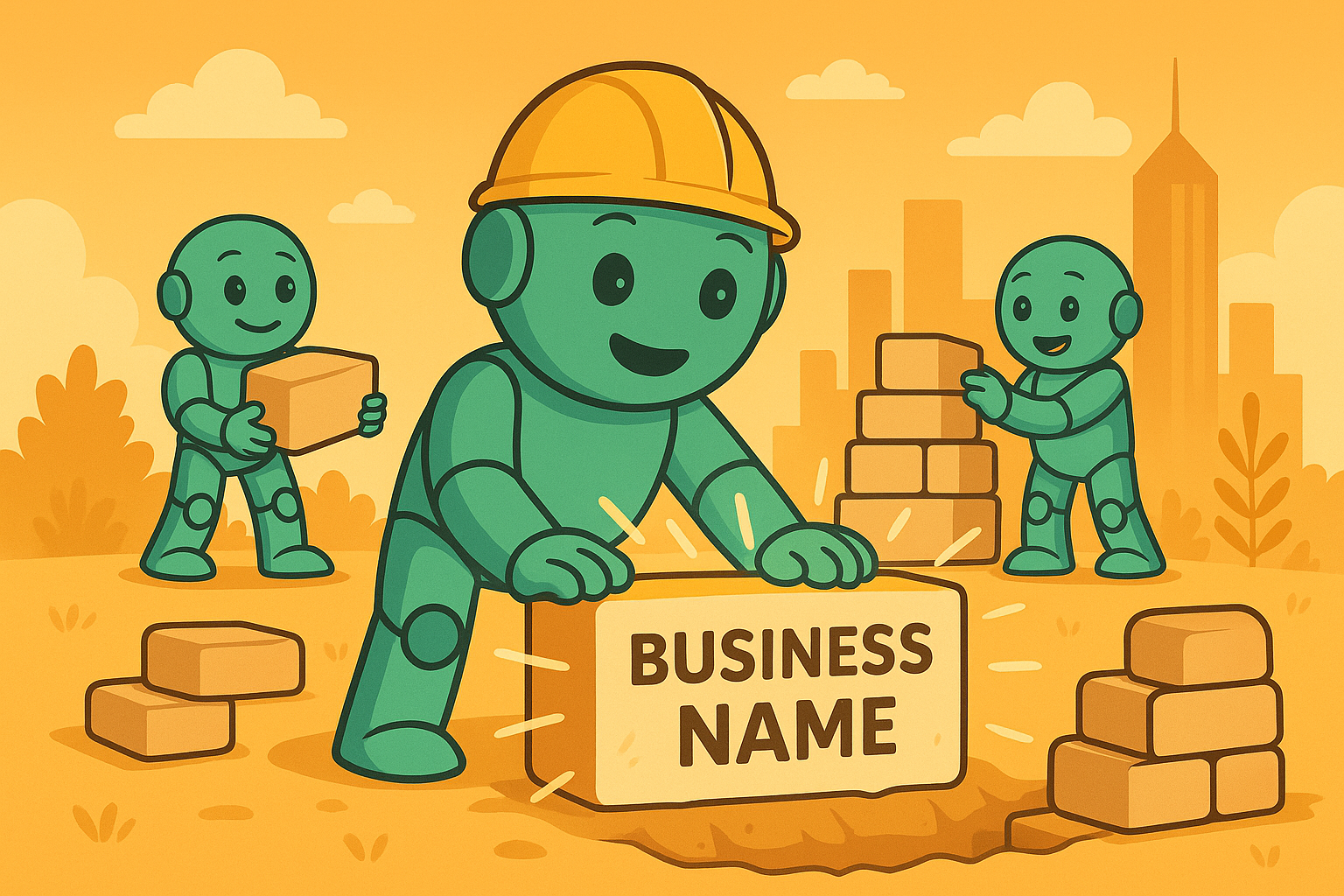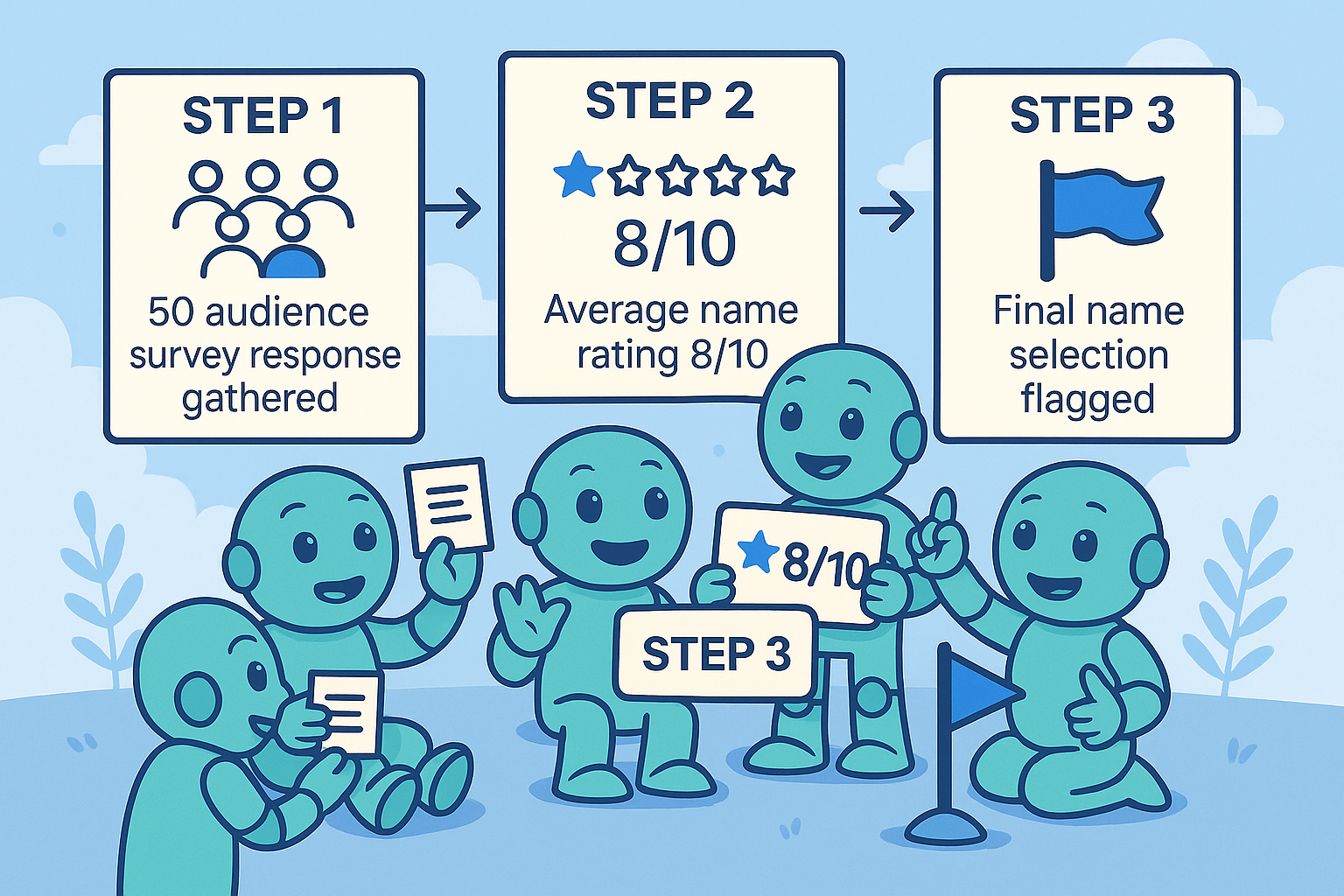How to Create a Business Name and Build Your Brand
Choosing a name for your business isn't just another item to tick off your to-do list. It's the very first block you lay in building your brand's identity, shaping how customers see you right from the get-go. Nailing the perfect business name is a blend of creativity and practicality—marrying your core brand values with the nitty-gritty of domain availability and trademark checks. This process ensures the name you fall in love with is not only memorable but also one you can legally own.
Your Business Name Is Your Brand's Foundation

A truly great name does more than just put a label on your company; it tells a story. Think about names like Patagonia or Warby Parker. Before you even know what they sell, the name itself evokes a certain feeling—a lifestyle, a promise. Your business name is your first and most persistent marketing tool, working for you 24/7. It directly impacts how well customers remember you, builds trust, and sets the entire tone for every marketing campaign you'll ever run.
This early decision carries a lot of weight, especially today. In a marketplace overflowing with options, a distinctive name is a real competitive edge. The global surge in new businesses has made this more crucial than ever. In 2023, there were an estimated 359 million companies worldwide, a significant jump from 328 million just a few years earlier in 2020. With nearly 100 million new businesses launching each year, standing out is no longer optional.
Pinpoint Your Core Brand Traits
Before you even think about brainstorming words, take a step back and define what your brand is all about. Are you gunning for innovative and modern, or are you rooted in tradition and reliability? Is your brand personality more playful and energetic, or is it sophisticated and serene?
Your brand traits are the adjectives that will steer your naming journey. They serve as a vital filter, helping you immediately toss out ideas that don't fit and instantly spot the ones that resonate with your mission.
Think of it like this: a business selling organic baby products would have a completely different set of core traits (gentle, natural, safe) compared to a shop specializing in high-performance auto parts (powerful, fast, durable). Getting these traits down on paper first prevents you from picking a name that, while clever, sends a confusing message to the very people you want to attract.
To get the wheels turning, consider which brand archetype fits you best:
- The Innovator: Names often feel futuristic, technical, or one-of-a-kind. Think Tesla or Google.
- The Sage: These names project wisdom, trust, and deep expertise, like The Mayo Clinic or Intuit.
- The Jester: Names here are typically playful, fun, and engaging. Mailchimp and Giphy are perfect examples.
By settling on 3 to 5 core traits, you create a solid framework that makes every other step in the process easier. This foundational work ensures that the business name you ultimately choose isn't just a label—it's a genuine reflection of your brand's soul.
Proven Brainstorming Methods for Creative Names

Now that you've pinned down your brand's personality, it’s time to move from abstract feelings to a real, tangible list of name contenders. Let's be honest: staring at a blank page is intimidating. The secret isn't waiting for a lightning bolt of inspiration, but rather using structured methods to generate a massive pool of ideas. The goal here is quantity over quality—we'll filter and polish later.
I always suggest dedicating a specific notebook or a fresh document just for this task. It’s a creative sandbox. The only rule? No judgment. Get every half-baked idea down on the page.
Master the Mind Map
A mind map is my go-to technique for getting the creative gears turning. It’s a visual way to explore the connections between your core concepts and the words that surround them.
Start by placing your central business idea in the middle of the page. Let's say you're launching a line of "sustainable home goods." From that core, you can start branching out into different themes.
For our example, those branches might look like this:
- Materials: wood, linen, clay, bamboo, recycled
- Feelings: calm, cozy, natural, simple, earthy
- Actions: craft, build, gather, nest, grow
- Locations: grove, hearth, meadow, haven
As you build out the map, you'll start seeing unexpected connections. You might pair "hearth" with "haven" to get "Hearthaven," or "bamboo" with "grove" for "Bamboo Grove." This free-association process is where the magic happens, helping you unearth word combinations you never would have found by just thinking linearly.
The point of brainstorming isn't to nail the perfect name on your first attempt. It's about creating a rich vocabulary—a pool of words, feelings, and concepts—that truly captures your brand's essence. The best names are almost always built from these raw ingredients.
Harness the Power of AI Tools
While nothing beats human creativity, AI-powered naming tools can be fantastic brainstorming partners. I don't use them to find the final name, but rather as a launchpad to explore new directions I hadn't considered. They excel at churning out hundreds of combinations based on your keywords.
Many platforms let you plug in keywords, your industry, and even the "vibe" you're after (like modern, classic, or evocative). Seeing how an algorithm mashes up your core concepts can be surprisingly inspiring. For a closer look at the different types of tools available, you can explore various business name generators that serve different creative needs.
The real value here is discovery. An AI might suggest a weird combination that sparks a completely original idea in your own mind. Think of it as a creative collaborator, not a final decision-maker.
Experiment with Different Name Styles
As your list of ideas grows, you'll notice they start falling into different categories. This is a good thing. A diverse list gives you more to work with later. I encourage founders to consciously try creating names in several distinct styles.
Common Name Constructions:
- Compound Words: The classic approach of mashing two words together. It’s direct and often descriptive. Think Facebook or YouTube.
- Evocative Names: These names hint at a feeling or an experience rather than describing the product literally. Nest is a perfect example for smart home tech, suggesting comfort and security without saying "thermostat."
- Altered Words: Taking a real word and giving it a twist. You might add a suffix, drop a vowel, or change the spelling. Tumblr and Activia are great examples of how this creates a unique, ownable brand.
- Abstract Names: These are completely invented words. They have no dictionary definition but sound good and feel right for the brand. Think Pepsi or Rolex.
By intentionally trying to craft names in each style, you push beyond your initial ideas and dramatically increase your odds of finding something memorable. Aim to have at least five strong options from your brainstorming session before you even think about moving on to the next phase.
How to Evaluate and Shortlist Your Name Ideas
Alright, the creative explosion of brainstorming is over. Now you're probably staring at a long, slightly chaotic list of potential names. This is where we shift from pure creativity to sharp strategy. Not all those ideas are winners, and our job now is to figure out which ones have what it takes to become a real, lasting brand.
This isn't just about picking the name you like the most. It's about putting each contender through a gauntlet of practical, real-world tests. A name might look brilliant on your screen but turn into a jumbled mess when someone tries to say it out loud or remember it five minutes later.
The First Cut: A Quick and Brutal Filter
Before you get too emotionally invested in any single name, it’s time for a ruthless first pass. Let's take your top 5-10 favorites and see if they can survive some basic scrutiny. This initial check is designed to quickly toss out any options with glaring, immediate flaws.
For each name on your list, ask yourself these simple questions:
- Is it easy to say? If people trip over the pronunciation, they simply won't talk about you. That's word-of-mouth marketing dead on arrival.
- Is it easy to spell? A name that needs a verbal footnote ("That's 'creative' but with a K and a V") just creates friction for anyone trying to find you online.
- Is it memorable? Does the name stick, or does it vanish into the ether a few seconds after you hear it? Research has shown that simpler, more fluent names tend to be viewed more positively by customers.
This quick check is surprisingly effective. A name like "Synergetix Solutions" might sound official, but it’s a pain to spell and say, making it a weak contender from the start. On the other hand, a name like "Grove" is clean, simple, and easy to recall.
A great business name should be intuitive. If you have to spend time explaining it, it's not working for you—you're working for it.
Will It Grow With You? Thinking About Scalability
One of the most common traps I see founders fall into is choosing a name that's far too specific. What seems perfectly descriptive today can become a cage that limits your growth tomorrow.
Take a name like "Seattle Web Design." It’s crystal clear, which is good. But what happens when your business starts offering brand strategy or you want to serve clients in Portland? The name is suddenly inaccurate and holds you back.
A truly scalable name grows with your business. Just look at Amazon. They started as an online bookstore, but the name "Amazon" was vast and abstract enough to eventually cover everything from cloud computing with AWS to fresh groceries. It didn’t pigeonhole them.
To test your names for scalability, ask:
- Does this name chain me to one specific product or service?
- Does it lock me into a single city, state, or country?
- Will this name still make sense if my business pivots or expands in the next five years?
Opting for something like "Apex Innovations" instead of "Apex Drone Repair" gives you the freedom to evolve without the headache and expense of a full rebrand later on.
Name Evaluation Checklist
To bring some objectivity to this process, use a scoresheet. This simple checklist helps you rate your top three contenders against the criteria that matter most. Just score each name from 1 (poor) to 5 (excellent) for each category.
A higher total score points to a stronger, more viable brand name.
| Evaluation Criteria | Name Idea 1 Score (1-5) | Name Idea 2 Score (1-5) | Name Idea 3 Score (1-5) |
|---|---|---|---|
| Easy to Say & Spell | |||
| Memorable & Unique | |||
| Reflects Brand Values | |||
| Scalable for Future Growth | |||
| Positive Connotations | |||
| Total Score |
Once you've filled it out, you'll have a much clearer, data-informed picture of which name truly stands out.
Don't Trust Your Gut Alone: Get Unbiased Feedback
You're too close to this. After staring at these names for hours or days, you've lost all objectivity. What sounds like a stroke of genius to you might have a bizarre or negative meaning to someone else. This is precisely why getting outside feedback is a step you cannot skip.
This image shows a great way to structure your feedback process so you can make a choice based on data, not just emotion.

By following a structured approach like this, you remove your own personal bias and get a clean read on how your name ideas land with a neutral audience.
Whatever you do, don't just ask your friends and family. They love you, and they'll likely tell you what they think you want to hear. Instead, find a small, diverse group of people who fit your target customer profile. You don't need a massive focus group; 10-15 thoughtful opinions are far more valuable than 100 vague ones.
Give them your top 3-5 names with zero context or explanation. Then ask:
- When you hear this name, what kind of business comes to mind?
- What feeling does this name evoke? (e.g., trustworthy, cheap, premium, fun)
- How would you spell it if you only heard it spoken once?
The answers you get are pure gold. This is how you uncover hidden problems—like a name that sounds too much like a competitor's or has an unfortunate slang meaning you never knew about. This feedback gives you the confidence to move forward, knowing your final choice has been properly vetted by the people who matter most: your future customers.
Checking Availability and Securing Your Name

So, you've brainstormed a list of names you love. This is where the rubber meets the road. A killer name is just a good idea until you can actually own it. Now it’s time to switch gears from creative thinking to practical detective work. This part is critical—it’s where you find out if your name is available both online and in the eyes of the law.
Don’t make the classic mistake of getting too attached before you've done your homework. Trust me, there's nothing worse than printing business cards and buying a domain, only to get a cease-and-desist letter a month later. This isn't just a box to check; it’s about laying a solid foundation for your brand.
Claiming Your Digital Real Estate
In this day and age, your online presence is your storefront, your billboard, and your business card all rolled into one. It all starts with your domain name and social media handles. Securing these isn't optional; it's the first step to existing in the market.
First, dive into a domain search. The .com is still the undisputed champion for its instant recognition, but don't feel boxed in. Other top-level domains (TLDs) can work just as well, and sometimes, even better.
- .io: A go-to for tech startups and SaaS products.
- .co: A solid, well-respected alternative to
.com. - .shop or .store: An obvious choice for any e-commerce venture.
Head over to a registrar like GoDaddy or Squarespace to see what’s available. If your first choice .com is taken, get creative. Try adding a verb like get[YourName].com or a qualifier like [YourName]hq.com. The key is finding a professional-sounding name that customers won’t misspell.
At the same time, check your potential name on all the social media platforms that matter for your business—think Instagram, TikTok, Facebook, LinkedIn, and X (formerly Twitter). Consistency is everything here. You want customers to find you easily, so strive to get the exact same handle everywhere.
A scattered digital identity dilutes your brand. Securing consistent handles and a strong domain name ensures that when customers look for you, they find you, not a competitor or an inactive account.
Navigating Preliminary Legal Checks
Once your digital assets are lined up, it’s time to tackle the legal side. You need to make sure your name isn't stepping on another company's trademarked toes. Skipping this can lead to incredibly expensive legal headaches later.
A great first step is a preliminary trademark search. If you’re in the U.S., the U.S. Patent and Trademark Office (USPTO) has a free database called TESS (Trademark Electronic Search System). You can search for names that are identical or sound similar to yours within your industry. To get a better handle on the process, you can get an overview of how to verify the availability of company names.
This initial search isn't a substitute for real legal advice from a trademark attorney, but it’s a smart way to spot obvious conflicts early. You'd be surprised how often a name that feels completely original is already in use.
The competition for online identity is fierce. As of 2024, there were approximately 378.6 million registered domain names worldwide, a number expected to hit nearly 460 million by 2030. This explosive growth underscores why finding and securing a unique name is so crucial. You can read the full research about domain name industry growth to get a sense of the landscape.
Understanding the Layers of Protection
Finally, it's vital to know the difference between simply registering your business and getting a trademark. They offer different types of protection.
- State Business Registration: When you form an LLC or corporation, you register your name with your state. This protects it only within that state, preventing another local business from using the same name.
- Federal Trademark: This is the big one. A federal trademark grants you exclusive rights to use your name for your specific goods or services nationwide.
Both are important. Registering your business makes it a legal entity. But trademarking it is what truly protects your brand identity on a larger scale. Doing these checks now gives you the confidence that the name you've chosen is one you can build on for years to come.
Finalizing Your Choice and Launching Your Brand
This is it—the moment of truth. After all that brainstorming, research, and vetting, you’ve finally found a name that feels right. It’s available, it’s memorable, and it captures the essence of your business. The key now is to act decisively. In my experience, hesitation at this stage is the most common and costly mistake.
Your first move should be to lock down your digital real estate, and I mean immediately. Go and purchase that domain name. The digital land grab is real; globally, over 33,000 new domains are registered every single day. That works out to a new registration about every 2.6 seconds. With over 762 million domains already taken, waiting even a few hours could mean your perfect name slips away. You can see just how competitive it is with these domain registration statistics from hostingadvice.com.
At the same time you're buying the domain, start claiming your social media handles. Grab your name on Instagram, TikTok, LinkedIn, Facebook, X—every platform that might be relevant to your business down the road. Even if you don't plan to post on a particular channel right away, securing the handle protects your brand's consistency and stops someone else from squatting on it.
Once you've secured the name, your energy should immediately shift from decision-making to brand-building. The goal is to start creating value and recognition for the name you worked so hard to find.
From Name to Brand Equity
Securing the name is just the starting line. Now the real work begins: infusing that name with meaning and value. Building brand equity doesn't require a massive budget, especially in the beginning. It's about taking small, strategic steps.
Here’s a practical checklist to get you started:
- Register Your Business: Make it official. Register your business entity—whether it's an LLC, sole proprietorship, or corporation—with the appropriate state or local authorities. This gives your name a crucial layer of legal protection.
- Develop a Simple Logo: You need a visual identity. Use a tool like Canva to create a clean, professional-looking logo. You can always hire a designer for a more elaborate version later, but for now, something simple is all you need.
- Set Up a "Coming Soon" Page: Put that new domain to work immediately. A simple landing page announcing your brand is coming soon builds anticipation and establishes a professional online footprint from day one.
- Create Initial Branding: Design a professional email signature and a basic digital business card. These small touches make your brand feel tangible and real in your earliest interactions.
Taking these immediate actions shifts your name from being just an idea to being a real business asset. For a deeper dive into making your name resonate, we have a complete guide on how to pick a good business name that sticks with customers. By moving swiftly, you smoothly transition from the naming process to the exciting work of building a brand that will drive your future growth.
Common Questions (and Expert Answers) on Naming a Business
Even with the best strategy, naming a business can feel like navigating a minefield. It’s natural for questions and a bit of uncertainty to pop up. Let's tackle some of the most common hurdles I see entrepreneurs face, so you can move forward with total confidence.
What if My Perfect Name is Already Taken?
This happens all the time. You land on what feels like the one, only to discover the .com is registered or another company in your space is already using it. It’s a gut punch, for sure. My best advice? Let it go and move on.
Seriously. Don't just tack on a hyphen, a number, or a clunky word like "group" to the end. That path almost always leads to customer confusion and can make your brand feel like a cheap imitation right out of the gate. Head back to your brainstorming list. Often, the name you're forced to find next turns out to be even stronger and more memorable.
Resisting the urge to settle for a slightly altered, unavailable name is crucial. It forces you to find a more distinct identity that you can truly own, which is a massive long-term advantage for your brand.
Should I Just Use My Own Name?
Ah, the classic question. Using your personal name can be a fantastic move, especially for consultants, artists, freelancers, or coaches where you are the brand. It feels personal, authentic, and it can easily grow with you as your business offerings change over the years.
But you have to think about the long game. If your name is fairly common—think "Jane Doe Consulting"—you might struggle to stand out in a crowded digital world. It can also create a perception problem if you want to bring on partners, hire a big team, or one day sell the company. If your vision is to build something that's bigger than just you, a more distinct, brandable name is usually the smarter play.
How Much Does the Name Really Matter?
It’s incredibly easy to get stuck here, endlessly searching for a “perfect” name and never actually starting the business. This is what we call analysis paralysis. The honest truth? Your brand is so much more than just its name.
Think about it. Did the word Apple have anything to do with computers? Or Amazon with online shopping? Not at all. Those names became powerful because of what the companies built around them: incredible products, reliable service, and a powerful brand story.
The goal isn't perfection. The goal is to find a good, solid name that isn't confusing, hard to spell, or legally risky. After that, your energy is far better spent building an amazing business. A decent name on a fantastic company will always win against a brilliant name on a mediocre one.
Ready to stop agonizing over the name and start building your brand? NameRobot offers a full suite of tools to help you find a creative and available name, from smart generators to instant domain and trademark checks. Find your perfect business name and get moving.















